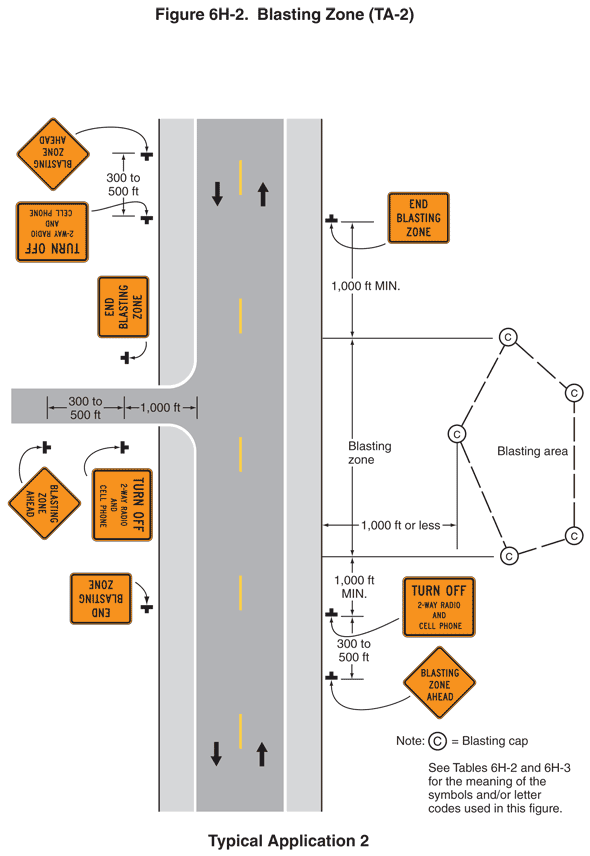2009 Edition Part 6 Figure 6H-2. Blasting Zone (TA-2)

Figure 6H-2. Blasting Zone (TA-2)
This figure illustrates an example of a blasting zone. A legend under the figure states that this is Typical Application 2. A note states that "C" is a blasting cap. Another note states "See Tables 6H-2 and 6H-3 for the meaning of the symbols and/or letter codes used in this figure."
This figure shows a vertical two-lane roadway with one lane of traffic in each direction. A downward-pointing black arrow in the left lane and an upward-pointing arrow in the right lane denote the direction of traffic as southbound and northbound, respectively. The opposing lanes are shown separated by a broken yellow line. A shoulder is shown to the right of each travel lane. The shoulders are shown separated from the travel lanes by a solid white line. One-third from the top of the figure, a horizontal side road is shown intersecting the vertical roadway from the left.
At the bottom of the figure and to the right of the shoulder of the right, northbound lane a black inverted "T" is shown denoting a sign. The sign shown is a diamond-shaped orange sign with a black border and the words "BLASTING ZONE AHEAD" in black. At a dimensioned distance of 300 to 500 ft beyond this sign, a horizontal rectangular orange sign with a black border is shown to the right of the right shoulder. It has the message "TURN OFF 2-WAY RADIO AND CELL PHONE" in black. It is shown at a dimensioned distance of 1,000 ft MIN. in advance of the blasting zone. The length of the blasting zone is shown as the dimension of the outer limits of the blasting area, shown by five "C's" denoting blasting caps, arranged in a pentagon shape. The blasting area is shown as a dimensioned distance of 1,000 ft or less from the right of the right edge of the right shoulder. At a dimensioned distance of 1,000 ft MIN. beyond the blasting zone, a horizontal rectangular orange sign with a black border is shown to the right of the right shoulder with the words "END BLASTING ZONE" in black.
At the top of the figure and to the right of the shoulder of the left, southbound lane, a black inverted "T" is shown denoting a sign. The sign shown is a diamond-shaped orange sign with a black border and the words "BLASTING ZONE AHEAD" in black. It is shown facing the southbound traffic. At a dimensioned distance of 300 to 500 ft beyond this sign, a horizontal rectangular orange sign with a black border is shown to the right of the right shoulder. It has the message "TURN OFF 2-WAY RADIO AND CELL PHONE" in black and also is shown facing the southbound traffic.
On the horizontal side road, a dimensioned distance of 1,000 ft to the left of the right edge of the right, southbound lane, a sign is shown to the right of the westbound lane of the side road to be visible to road users exiting the vertical roadway and turning onto the side road. It is shown as a horizontal rectangular orange sign with a black border and the words "END BLASTING ZONE" in black. To the right of the eastbound lane of the side road, a sign is shown facing road users approaching the vertical roadway from the horizontal road. It is shown as a diamond-shaped orange sign with a black border and the words "BLASTING ZONE AHEAD" in black. It is shown as a dimensioned distance of 300 to 500 ft in advance of a horizontal rectangular orange sign with a black border and the words "TURN OFF 2-WAY RADIO AND CELL PHONE" in black. It is shown as a dimensioned distance of 1,000 ft in advance of the right edge of the right, southbound lane of the vertical roadway.
South of the horizontal side road on the vertical roadway and to the right of the shoulder, a horizontal rectangular orange sign is shown with a black border and the words "END BLASTING ZONE" in black. It is shown as a dimensioned distance of 1,000 ft MIN. past the blasting zone to the right of the right lane.
